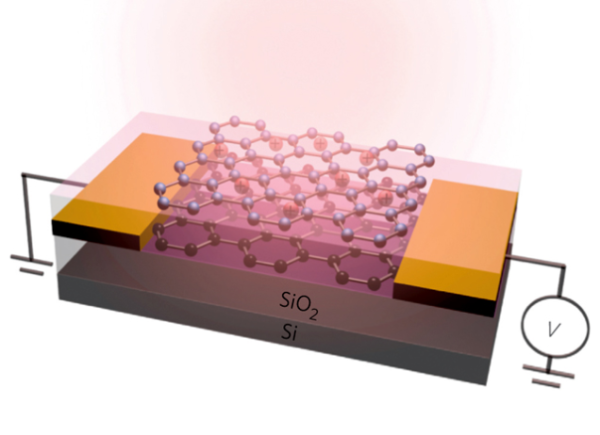 According to a recent report, it appears that researchers at the University of Michigan may have found a way to create contact lenses which would give the wearer infrared “night vision.”
According to a recent report, it appears that researchers at the University of Michigan may have found a way to create contact lenses which would give the wearer infrared “night vision.”
Unlike current night vision goggles which are large and bulky, these new contact lenses would allow people to see in the dark as easily as they do in the day without any external hardware.

Credit: University of Michigan
The recent breakthrough is all based on a demonstration last year by IBM scientists who demonstrated the photoconductivity mechanisms of grapheme and how it can be used as an infrared detector.
Incredibly thin, the width of a single atom, Graphene not only detects light in the infrared, but also visible light and ultraviolet. This would allow the wearer to see in a much broader way, in addition to our current visible world.
Unfortunately, because it is so thin graphene can only absorb about 2.3 percent of the light that hits it – which is not enough to generate an electrical signal. This signal is a must in order for it to operate as an infrared sensor.
“The challenge for the current generation of graphene-based detectors is that their sensitivity is typically very poor,” said Zhaohui Zhong, assistant professor at the University of Michigan, in a press release. “It’s a hundred to a thousand times lower than what a commercial device would require.”
To clear this hurdle, researchers devised a new method for generating the electrical signal. According to the article published in the journal Nature Nanotechnology, instead of trying to measure the electrons that are released when the light strikes the material, they amplified an electrical current that is near the electrical signals generated by the incoming light.
The team sandwiched an insulator between two sheets of grapheme with a current running through the bottom sheet, such that when light hits the top sheet, electrons are freed and positively charged electron holes are generated.
These holes generate an electric field which can be measured allowing researchers to determine the amount of light hit which hits the top layer.
So far the researchers have produced infrared sensors the size of a pinky finger nail.
“If we integrate it with a contact lens or other wearable electronics, it expands your vision,” Zhong said in the release. “It provides you another way of interacting with your environment.”
![Herbal Reference Substances are Key to Everyday Products <!-- AddThis Sharing Buttons above -->
<div class="addthis_toolbox addthis_default_style " addthis:url='https://newstaar.com/herbal-reference-substances-are-key-to-everyday-products/3512112/' >
<a class="addthis_button_facebook_like" fb:like:layout="button_count"></a>
<a class="addthis_button_tweet"></a>
<a class="addthis_button_pinterest_pinit"></a>
<a class="addthis_counter addthis_pill_style"></a>
</div>When it comes to quality control testing and the development of new products, Botanical Reference Materials (BRMs), also known as Herbal References are critically important. To help companies ultimately obtain all-important FDA approval, the Food and Drug Administration provides in its guidance a recommendation that […]<!-- AddThis Sharing Buttons below -->
<div class="addthis_toolbox addthis_default_style addthis_32x32_style" addthis:url='https://newstaar.com/herbal-reference-substances-are-key-to-everyday-products/3512112/' >
<a class="addthis_button_preferred_1"></a>
<a class="addthis_button_preferred_2"></a>
<a class="addthis_button_preferred_3"></a>
<a class="addthis_button_preferred_4"></a>
<a class="addthis_button_compact"></a>
<a class="addthis_counter addthis_bubble_style"></a>
</div>](https://newstaar.com/wp-content/uploads/2021/02/Achillea_millefolium_flowers-100x100.jpg)
![Quality Electrochemical Biosensors are Critical for Medical, Food and Chemical Industry <!-- AddThis Sharing Buttons above -->
<div class="addthis_toolbox addthis_default_style " addthis:url='https://newstaar.com/quality-electrochemical-biosensors-are-critical-for-medical-food-and-chemical-industry/3512086/' >
<a class="addthis_button_facebook_like" fb:like:layout="button_count"></a>
<a class="addthis_button_tweet"></a>
<a class="addthis_button_pinterest_pinit"></a>
<a class="addthis_counter addthis_pill_style"></a>
</div>A number of industries have, at their core, a need to frequent or even continuous analysis of biological media. These include the medical and pharmaceutical fields, biotech firms, and food and chemical companies. To maintain quality standards and develop new products, these industries rely heavily […]<!-- AddThis Sharing Buttons below -->
<div class="addthis_toolbox addthis_default_style addthis_32x32_style" addthis:url='https://newstaar.com/quality-electrochemical-biosensors-are-critical-for-medical-food-and-chemical-industry/3512086/' >
<a class="addthis_button_preferred_1"></a>
<a class="addthis_button_preferred_2"></a>
<a class="addthis_button_preferred_3"></a>
<a class="addthis_button_preferred_4"></a>
<a class="addthis_button_compact"></a>
<a class="addthis_counter addthis_bubble_style"></a>
</div>](https://newstaar.com/wp-content/uploads/2020/10/Electrochemical-Biosensor-100x100.jpg)
![Company Develops Industrial Mixers Well-Suited for both Fragile and Explosive Products <!-- AddThis Sharing Buttons above -->
<div class="addthis_toolbox addthis_default_style " addthis:url='https://newstaar.com/company-develops-industrial-mixers-well-suited-for-both-fragile-and-explosive-products/3512071/' >
<a class="addthis_button_facebook_like" fb:like:layout="button_count"></a>
<a class="addthis_button_tweet"></a>
<a class="addthis_button_pinterest_pinit"></a>
<a class="addthis_counter addthis_pill_style"></a>
</div>Industrial drum mixers are normally applied to blend mixes of varying viscosities such as adhesive slurries or cement. Some of these mixers have the capability of blending mixes of very different particle sizes such as fruit and ice cream, and gravel and cement slurry. The […]<!-- AddThis Sharing Buttons below -->
<div class="addthis_toolbox addthis_default_style addthis_32x32_style" addthis:url='https://newstaar.com/company-develops-industrial-mixers-well-suited-for-both-fragile-and-explosive-products/3512071/' >
<a class="addthis_button_preferred_1"></a>
<a class="addthis_button_preferred_2"></a>
<a class="addthis_button_preferred_3"></a>
<a class="addthis_button_preferred_4"></a>
<a class="addthis_button_compact"></a>
<a class="addthis_counter addthis_bubble_style"></a>
</div>](https://newstaar.com/wp-content/uploads/2020/06/bandeau-sofragir2-100x100.jpg)